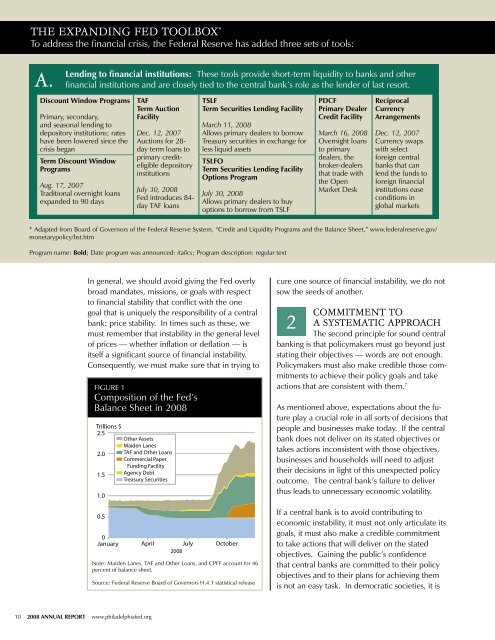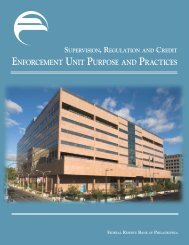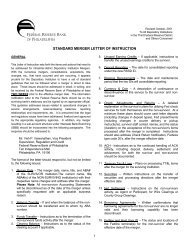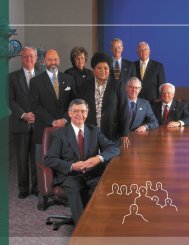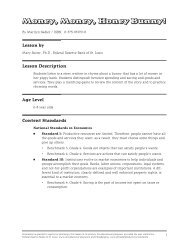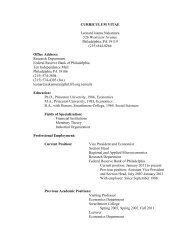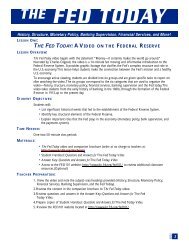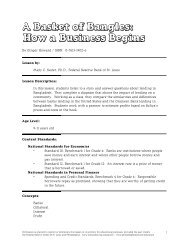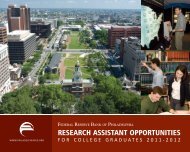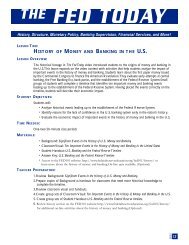Complete 2008 Annual Report - Federal Reserve Bank of Philadelphia
Complete 2008 Annual Report - Federal Reserve Bank of Philadelphia
Complete 2008 Annual Report - Federal Reserve Bank of Philadelphia
Create successful ePaper yourself
Turn your PDF publications into a flip-book with our unique Google optimized e-Paper software.
The Expanding Fed Toolbox *<br />
To address the financial crisis, the <strong>Federal</strong> <strong>Reserve</strong> has added three sets <strong>of</strong> tools:<br />
A.<br />
Lending to financial institutions: These tools provide short-term liquidity to banks and other<br />
financial institutions and are closely tied to the central bank’s role as the lender <strong>of</strong> last resort.<br />
Discount Window Programs<br />
Primary, secondary,<br />
and seasonal lending to<br />
depository institutions; rates<br />
have been lowered since the<br />
crisis began<br />
Term Discount Window<br />
Programs<br />
Aug. 17, 2007<br />
Traditional overnight loans<br />
expanded to 90 days<br />
TAF<br />
Term Auction<br />
Facility<br />
Dec. 12, 2007<br />
Auctions for 28-<br />
day term loans to<br />
primary crediteligible<br />
depository<br />
institutions<br />
July 30, <strong>2008</strong><br />
Fed introduces 84-<br />
day TAF loans<br />
TSLF<br />
Term Securities Lending Facility<br />
March 11, <strong>2008</strong><br />
Allows primary dealers to borrow<br />
Treasury securities in exchange for<br />
less liquid assets<br />
TSLFO<br />
Term Securities Lending Facility<br />
Options Program<br />
July 30, <strong>2008</strong><br />
Allows primary dealers to buy<br />
options to borrow from TSLF<br />
PDCF<br />
Primary Dealer<br />
Credit Facility<br />
March 16, <strong>2008</strong><br />
Overnight loans<br />
to primary<br />
dealers, the<br />
broker-dealers<br />
that trade with<br />
the Open<br />
Market Desk<br />
Reciprocal<br />
Currency<br />
Arrangements<br />
Dec. 12, 2007<br />
Currency swaps<br />
with select<br />
foreign central<br />
banks that can<br />
lend the funds to<br />
foreign financial<br />
institutions ease<br />
conditions in<br />
global markets<br />
* Adapted from Board <strong>of</strong> Governors <strong>of</strong> the <strong>Federal</strong> <strong>Reserve</strong> System, “Credit and Liquidity Programs and the Balance Sheet,” www.federalreserve.gov/<br />
monetarypolicy/bst.htm<br />
Program name: Bold; Date program was announced: italics; Program description: regular text<br />
In general, we should avoid giving the Fed overly<br />
broad mandates, missions, or goals with respect<br />
to financial stability that conflict with the one<br />
goal that is uniquely the responsibility <strong>of</strong> a central<br />
bank: price stability. In times such as these, we<br />
must remember that instability in the general level<br />
<strong>of</strong> prices — whether inflation or deflation — is<br />
itself a significant source <strong>of</strong> financial instability.<br />
Consequently, we must make sure that in trying to<br />
FIGURE 1<br />
Composition <strong>of</strong> the Fed’s<br />
Balance Sheet in <strong>2008</strong><br />
Trillions $<br />
2.5<br />
Other Assets<br />
Maiden Lanes<br />
2.0 TAF and Other Loans<br />
Commercial Paper<br />
Funding Facility<br />
1.5 Agency Debt<br />
Treasury Securities<br />
1.0<br />
0.5<br />
0<br />
January April July October<br />
<strong>2008</strong><br />
Note: Maiden Lanes, TAF and Other Loans, and CPFF account for 46<br />
percent <strong>of</strong> balance sheet.<br />
Source: <strong>Federal</strong> <strong>Reserve</strong> Board <strong>of</strong> Governors H.4.1 statistical release<br />
cure one source <strong>of</strong> financial instability, we do not<br />
sow the seeds <strong>of</strong> another.<br />
Commitment to<br />
2 a Systematic Approach<br />
The second principle for sound central<br />
banking is that policymakers must go beyond just<br />
stating their objectives — words are not enough.<br />
Policymakers must also make credible those commitments<br />
to achieve their policy goals and take<br />
actions that are consistent with them. 7<br />
As mentioned above, expectations about the future<br />
play a crucial role in all sorts <strong>of</strong> decisions that<br />
people and businesses make today. If the central<br />
bank does not deliver on its stated objectives or<br />
takes actions inconsistent with those objectives,<br />
businesses and households will need to adjust<br />
their decisions in light <strong>of</strong> this unexpected policy<br />
outcome. The central bank’s failure to deliver<br />
thus leads to unnecessary economic volatility.<br />
If a central bank is to avoid contributing to<br />
economic instability, it must not only articulate its<br />
goals, it must also make a credible commitment<br />
to take actions that will deliver on the stated<br />
objectives. Gaining the public’s confidence<br />
that central banks are committed to their policy<br />
objectives and to their plans for achieving them<br />
is not an easy task. In democratic societies, it is<br />
10 <strong>2008</strong> <strong>Annual</strong> <strong>Report</strong> www.philadelphiafed.org


